Sowing seeds – expert tips for more flowers and better germination
Sowing seeds in autumn can give you stronger, healthier plants and earlier flowers.
But it’s not right for all seeds. Or, indeed, for all gardeners! Some people prefer to take a rest from gardening in winter.
So I’ve asked Sue Oriel, who runs Country Lane Flowers in Kent with her business partner, Stephanie Bates, for her advice.
Sue and Stephanie grow all the flowers they sell in their own gardens. They do weddings, special events and have a roadside flower stall at weekends in Owens Court Road, Faversham.
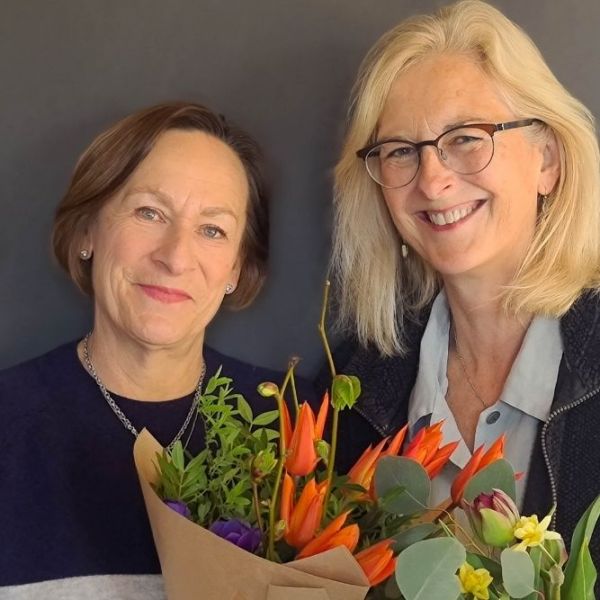
Sue Oriel and Stephanie Bates, who grow the flowers for their Country Lane Flowers in their own gardens.
They plant some of their seeds in September for flowering the following year. So I asked Sue for her expert seed sowing tips. You can see them in video here if you prefer.
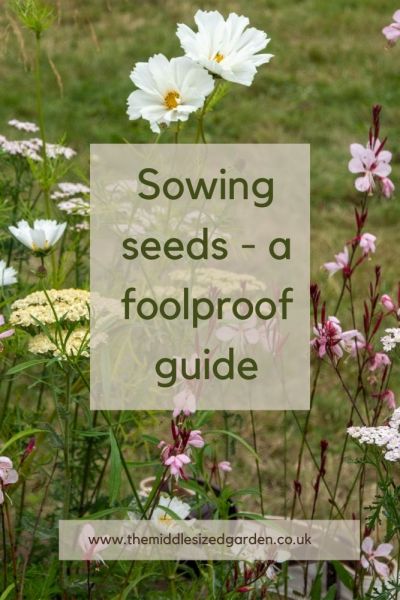
Tina Worboys won Best Border at BBC Gardeners World Live for her meadow border, full of flowers she had grown herself from seed. See more beautiful borders here in 10 new garden ideas from the show.
Sowing seeds in autumn – which flowers to sow?
Sue says that there are four kinds of flowering plant you can grow from seed. They are perennials, biennials, half-hardy annuals and hardy annuals.
Perennials are plants which grow for three years or more in your garden. You can sow many from seed in autumn, but most people buy perennials as plants rather than growing them from seed.
Biennials are plants you sow from seed one year to flower the following year. Typically you would sow seed for biennials early spring to mid-summer for flowering the following summer. September is too late to sow biennial seeds.
Half-hardy annuals also grow from seed, flower and die in one year, but they won’t survive winter. So sowing seeds of half-hardy annuals in September is a bad idea.
Hardy annuals are plants that grow from seed, flower and die in one 12 month period. They will survive a UK winter, where it’s rare for temperatures to drop below around minus 6C or 21F.
So if you’re sowing seeds in September or October, stick to hardy annuals. You should get stronger, healthier plants and you may get earlier flowers, depending on the weather.
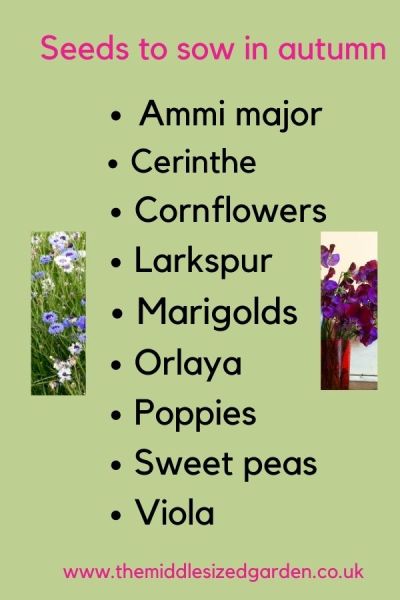
What are the advantages of sowing seeds in autumn?
Sue says that sowing seeds in autumn gives the plant a chance to develop a good strong root system. She sows from seed in September and then often plants the seedling out into its final place in the garden around 4-6 weeks later.
‘A cornflower that’s grown from seed and then planted out in autumn will always be stronger and straighter than one grown from seed in early spring and planted out in March or April,’ she says. ‘You’ll get a bigger, bushier, healthier plant if they’re in the ground for longer.’
Many studies have shown that flowers like sweet peas can flower up to six weeks earlier if sown from seed in autumn.
However, you don’t have to plant the autumn-sown plants out in the garden. Many people keep the plants on a cool window-sill or in a greenhouse until the spring. There are still benefits.
But Sue says that ‘some flowers will flower earlier if sown in autumn and others won’t. It depends what happens to them as they grow. If it’s cold when they’re planted out, their root system will get better established, but they won’t necessarily flower any earlier.’
Sowing seeds – insider tips
Firstly, Sue says ‘be very sparing with the seed. When I was an amateur, I planted the whole seed packet, scattering it across a tray of compost. Now I use modules and only put one or perhaps two seeds in each module.’
She says that if you store your seed correctly, in a dark, dry place, then seed will last for years. ‘I don’t take much notice of ‘use by’ dates on seeds,’ she admits. Although, she adds, at any time or for any reason, you can find that a packet of seeds just doesn’t germinate.
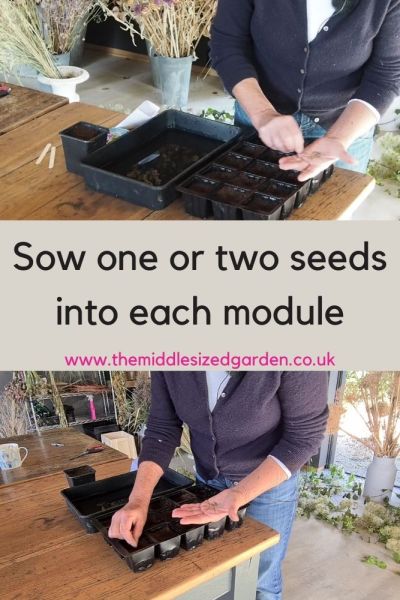
Seed compost is critical
It’s essential to use specialist seed compost rather than ordinary potting compost, says Sue. ‘Seeds have already got all their nutrition in the seed and they don’t need any extra from the potting compost.’
But seeds need well drained compost and that’s what seed compost is.
Once you’ve filled your seed tray or pot, give it a gentle shake to settle the compost. This prevents any air pockets.
Use a heated propagator or mat
Sue always uses a heated propagator or stands her seed trays on a heat mat – but only until they’ve germinated.
A heated propagator really helps seeds germinate, but as soon as you see the first two little leaves, move the plants somewhere cooler.
They then need to be somewhere cool or frost-free. A greenhouse is ideal. but if you don’t have a greenhouse then you can use a windowsill in an unheated room. If you try to grow seedlings in too warm a spot over winter, they will get leggy and won’t do so well.
What is damping off and how to avoid it?
‘Damping off’ is a virus which makes seedlings collapse at soil level. They never recover,’ says Sue.
It’s caused by growing seedlings in too-damp conditions, which is why free draining seed compost is so important. And it can also be transferred via re-used seed trays and modules.
So Sue advises that you always wash your seed growing equipment after every use.
How to plant seeds
Sue says that seeds usually need to be planted at about twice the depth of the seed. So a very small seed won’t need to be planted deeply. She suggests making a depression in the soil with your finger or a pencil.
Drop one – or at the most – two seeds into each module. Cover over with the soil and give the tray a gentle shake to settle the soil. You can also sprinkle seed compost over the top if you prefer.
Don’t forget to label your tray!
Then water the seed tray from the bottom.
How to water seedlings
‘Always water seedlings from below,’ advises Sue. ‘Never spray from above.’ She fills a slightly larger tray with water, then lowers the tray of seedlings in and leaves it for about 10 minutes so the soil will absorb all the water it needs.
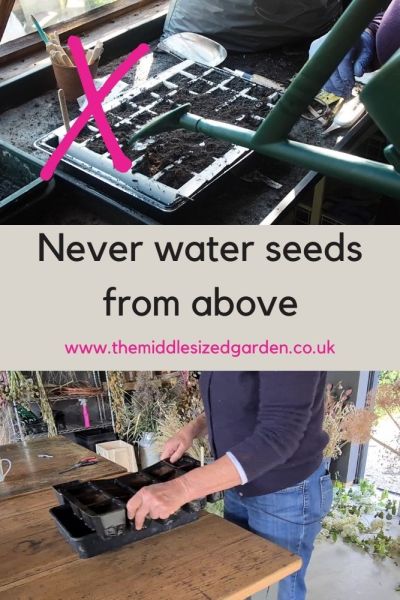
When sowing seeds, it’s essential to water the seed tray or pot from below. Never spray water onto the seeds from above. You will cause damping off and other problems.
Hardening off is also vital
When you’re moving seeds from a greenhouse or potting shed to outside, it’s essential to harden them off. This means leaving them outside for an increasing length of time for about a week or 10 days.
Start with a couple of hours outside a day. And leave them outside for an hour or so longer each day.
How to handle seedlings
If you’ve sown a tray of seeds and they have all germinated, you’ll need to thin them out. That means taking out the least healthy looking seedlings so they’re not competing with the others.
Wait until they have a pair of ‘true’ leaves.
When a seed sprouts and grows its first pair of leaves, the leaves don’t look like the ones they’ll have when they’re a proper plant. The next set of leaves will be their ‘true’ ones, which will look like the leaves on the adult plant.
Don’t transplant or thin out seedlings until you can see their first ‘true’ leaves.
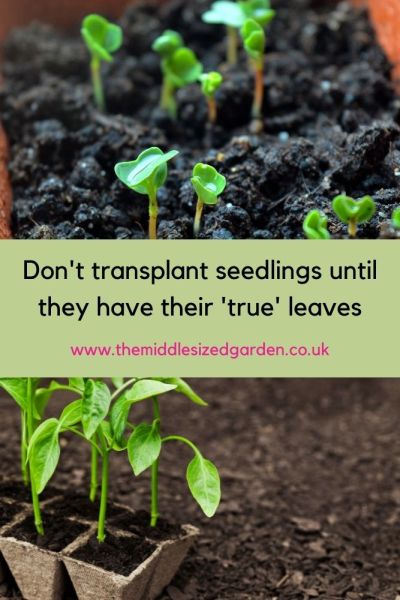
The first leaves that emerge from the seed are little round things that don’t resemble the plant. Don’t transplant seedslings at this stage, but remove from a propagator or heat mat.
Always handle seedlings by the leaves. Don’t touch the roots or the stems as they are very fragile.
Sowing seeds without a greenhouse
If you’re growing seeds indoors without any special equipment, Sue suggests starting them off in a warm room on a sunny windowsill.
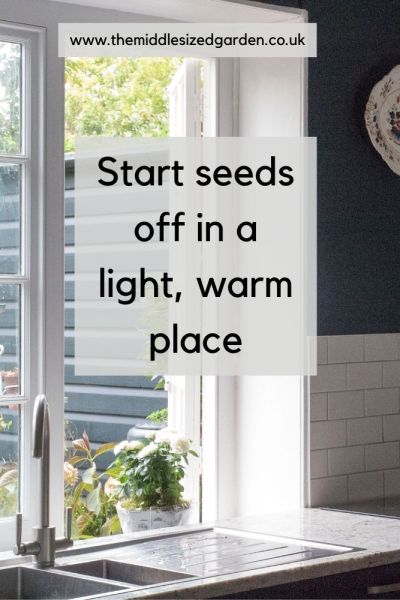
If you’re growing seeds on a windowsill, choose a bright, warm place such as a kitchen window. A heated mat or propagator will help germination.
Then, when they germinate, move them to a cooler place. But they still need good sunshine. ‘An unheated spare room, a porch or even a window in your garage will all be good places to grow seedlings,’ says Sue.

Move seedlings to an unheated but sunny area once they’ve germinated. This is garden writer Francine Raymond’s garage, converted to a sunroom. See how she went from garage to garden room on a tight budget here.
Seed sowing equipment and more
I bought two propagators. One is intended specifically for a windowsill. The other is the standard size heated propagator tray. You can lower individual pots or a tray of individual modules into it. Note that links to Amazon are affiliate, which means I may get a small fee if you buy, but it won’t affect the price you pay.
I often re-use the trays that come with small plants when I buy them from the garden centre. They can be re-used over and over again for years. Or I’ve used these seed trays, also re-usable. Sue says always wash your trays when you re-use them.
Peat-free seed sowing?
I’ve seen a few people on social media saying that they’ve tried peat-free seed composts for the first time, but had disappointing results.
I’ve been entirely peat-free for five years. In that time, I’ve had the same proportion of successes and failures in my seed trays as I did when I was using peat-based seed composts.
I now realise that I was doing several things wrong. Mainly I was watering too much and watering from above.
But sometimes it wasn’t my fault. Sometimes a pack of seeds is faulty. You can’t judge a seed compost on the performance of one or two trays of seeds. I know many gardeners who have been peat-free for years. And they all say that their seeds regularly germinate well.
I was recently sent some peat-free Carbon Gold Biochar composts to try. The Carbon Gold Biochar seed compost contains mycrorrhizal funghi, biochar, worm casts and other elements to help improve root development while the seedlings are growing in the compost. The chemistry around biochar is complex and research is still ongoing, but studies so far show that it improves drainage in soil, which is important for seed compost.
And when you transplant seedlings on, the mycorrhizal funghi, seaweed feed and other elements in the Carbon Gold Biochar potting compost helps improve seedling and plant growth and resilience.
Pin to remember seed sowing tips:
And do join us – see here for a free weekly email with tips, ideas and inspiration for your garden.
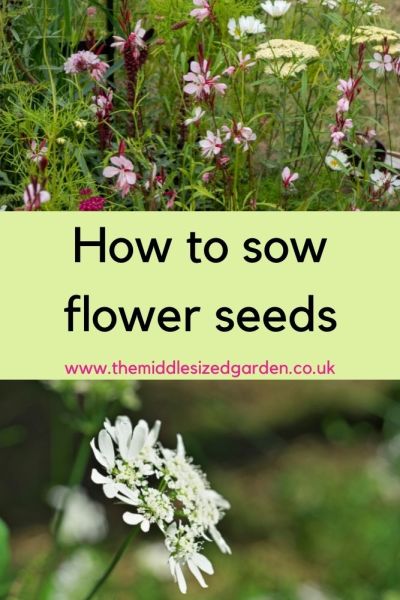
























Hiya, this is a brilliant article and has been really helpful.
Perhaps by fact that you haven’t covered what I’m going to ask says that it shouldn’t be done but … always a but … can I put seeds in seeds trays and just put outside in June? Not cover them or anything?
Thanks
Xx
Yes, you can, provided they’re seeds that can be planted at that time. You might find the seedlings are more likely to be attacked by slugs and snails if they’re outside, but if you put them up on shelves, that may deter some of them.
I have a town garden in Oxford which this year has been very dry and hot on the west side due to overhanging trees. In order to improve the soil should I be putting down straw mulch now or soil improver in the spring?
You can do either, but personally I would add a layer of garden compost, soil improver or well rotted manure over the top of the soil now. Don’t dig it in, just let the worms and microbes do the work for you. Sometimes I add another layer after planting in the spring
Thank you so much for this wonderful advice. I will never water seeds or seedlings from the to again. You are both very kind and generous with your time and expertise. Great stuff.
Thank you!
Thanks